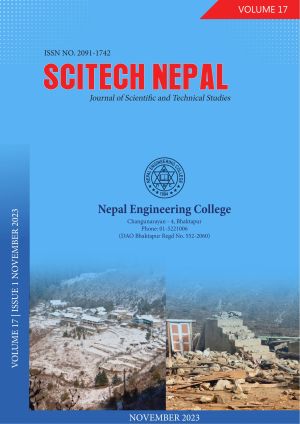Behavior And Optimum Location Of Outrigger And Belt Truss System In High-Rise Buildings Subject To Seismic Loading
DOI:
https://doi.org/10.3126/scitech.v17i1.60465Keywords:
Outrigger, Belt truss system, Earthquake, Lateral displacement, Out-outrigger, OFT-Outrigger fixed at the top and another variable, OBT-Outrigger and Belt Truss systemAbstract
This study is focused on the efficient use of the lateral load-resisting system for high-rise concrete buildings subjected to earthquake load. 32-storey three-dimensional models of OMRF, SMRF, core, core with outrigger (OT), core with outrigger and cap truss, and core with belt truss (BT) and core with belt truss and their cap truss systems are analyzed and compared to find the lateral displacement, storey drift and time-period reduction. The modelling and analysis were performed using finite element software ETABS 2016. The analysis has been carried out to study the effect and performance of the outrigger system and belt truss system in the building. These systems are provided at different levels along the height of the building. The coverage of the outrigger and belt trusses are equal to the height of the typical story and maintained the same in all the models. For finding the optimum position of the outrigger and belt truss system and also with their cap truss, the result is illustrated in terms of the reduction of top-storey lateral deflection, the maximum reduction in storey drift and the maximum reduction in the time period of the building. All the parameters are obtained for the structure without an outrigger system and they are compared with the values obtained by introducing an outrigger and belt truss. A total of 51 models are studied for finding the optimum location and behaviour of the systems when introduced on the building. A comparison is made to find the best system among all the systems, which are introduced in the model. Among the entire systems, an outrigger with a belt truss is found to be the best system in terms of reducing deflection, drift, time and base shear. The optimum position is found to be at 0.375 times the height of the total structure when the user system is outrigger and its belt system in terms of reduction in deflection and time, whereas the optimum position is at mid-height when the selection criterion is lateral drift.




